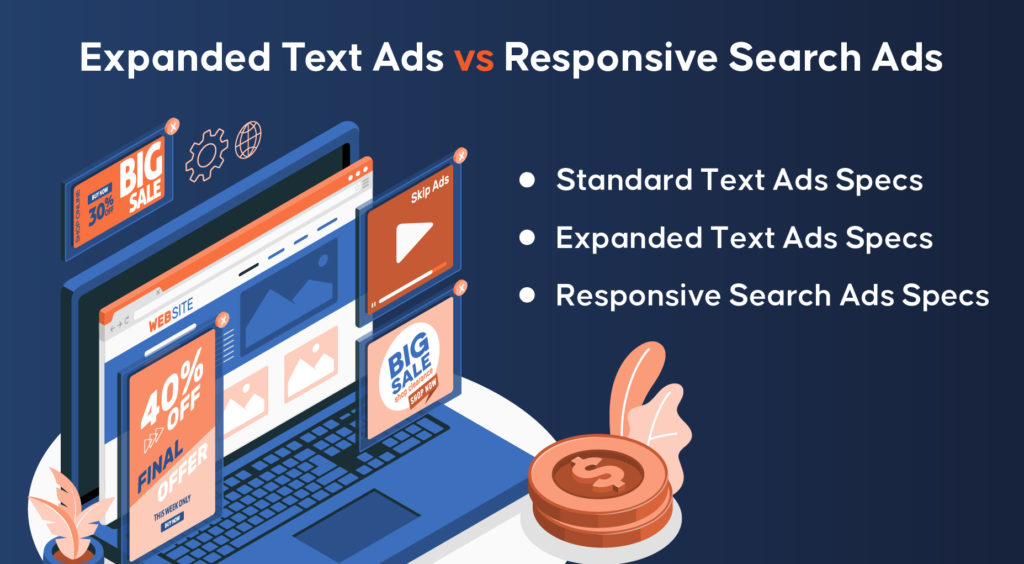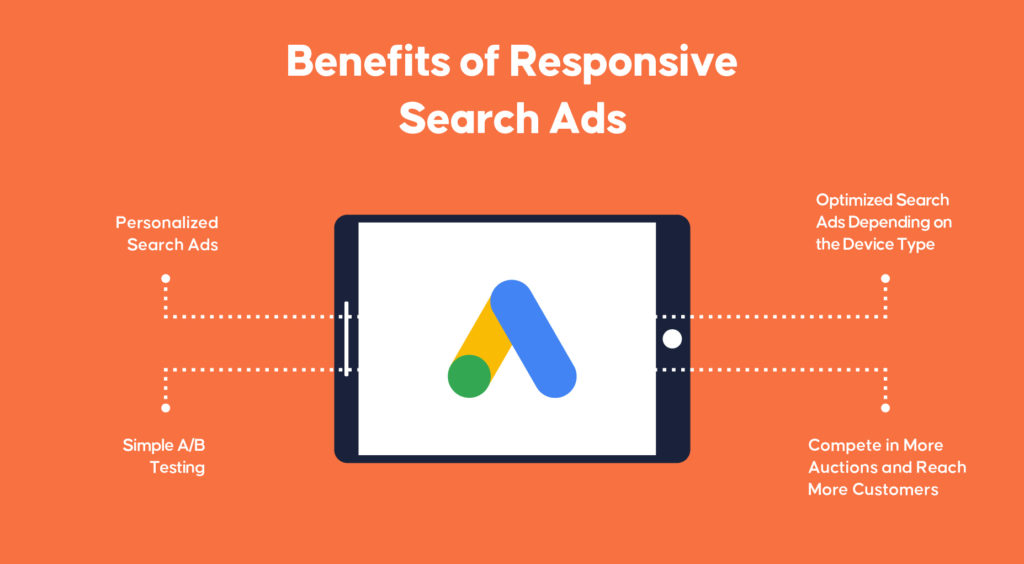Inquivix HQ
1-903, 18 Eonju-ro 146-gil,
Gangnam-gu, Seoul, Korea
06057

Advertising campaigns have evolved over the years from traditional campaigns like billboards to Google ad campaigns and other online advertising resources and platforms. Google search ads are constantly improving how businesses show up in search engines for a consumer’s query and have thus come up with responsive search ads (RSAs) with plans to not allow users to create or edit any more expanded text ads from June 30, 2022.
Google’s meticulous creation of the responsive search ad feature ensures that a search ad doesn’t stay static and boring for users that have various queries and various different ways of searching for these queries. As the name suggests, “responsive” search ads are highly responsive to consumer searches, increasing the benefits of search advertising to companies. It increases the chances of your brand showing up in search results and allows advertisers to provide headlines and descriptions that combine with machine learning to display the most appropriate search results. Here’s a detailed guide on how Google Ads generates RSAs and how this ad type works great for your PPC campaigns.
What are Responsive Search Ads?
Responsive search ads are a terrific search advertising tool for businesses. This Google ad campaign allows advertisers to provide up to 15 individual headlines and 4 description options most appropriate for their business. Combined with the search engine’s AI (artificial intelligence), RSAs display the most appropriate search results as responses to search queries on the Google Ads interface from up to 32,670 combinations of headlines and descriptions.
Google wanted to create more opportunities for Google searches to be highly responsive in showcasing a business’s advertisements and reaching potential customers more effectively. Advertisers use Google’s flexible approach to provide different copy elements, and these different combinations perform together to answer the question at the top of the mind of a consumer. Below, we have outlined how a responsive search ad works and how an advertiser can best use it.

How do they work?
The Google Ads platform advertises a business by combining the most relevant information provided by the advertiser with the right audience as they type in their search queries. With four description options and 15 headlines, the advertiser is spoilt for opportunities to describe their business and can also tag the relevant page of their website that they think is not receiving enough attention despite its potential for customer retention and lead generation. Google’s SERP will only show up to 3 headlines and 2 descriptions, so Google’s machine learning is at the liberty of displaying the most suitable ad content customized to the search, consumption, and other criteria.
However, advertisers have more control over a responsive search ad as they also have the choice of pinning headlines and descriptions in specific positions, which ensures they are displayed along with the analyzed combination that the search engine comes up with as a response to a search query. This is a great service by Google for advertisers, and it makes search advertising an amazing resource to reach potential customers. Before RSAs came into the picture, advertisers used expanded text ads. When we compare the two ad formats, you can see why responsive search ads will be better for your business.
Responsive Search Ads vs Expanded Text Ads
Google has always been conscious of its consumers, whether advertisers or users looking to find something. To bridge the gap between the two and provide a better consumer experience by understanding its users’ needs, the search engine platform is constantly finding ways to improve and meet the expectations of its consumers. It is no surprise that Google approaches Google ads the same way.

Therefore, to understand how the ad formats of Google have evolved from the beginning, what expanded text ads are and the difference between ETAs and RSAs, we’ll need a quick run-through of how things were when Google first started its involvement in support ad campaigns. Initially called Google AdWords, here is an outline of how Google Ads went from standard text-based ads to ETAs and now RSAs.
Standard Text Ads Specifications
Google Ads, later Google AdWords, introduced text-based ads with a single headline of 25 characters and two descriptions of 35 characters each. It provided users with a 95-character opportunity to advertise their organization.
Specifications for Expanded Text Ads
Once Google understood the incoming wave of the mobile-first world, the company introduced expanded text ads in mid-2016, providing advertisers a window to shift to expanded text ads from standard text ads until the end of January 2017.
Initially, ETAs had one 80-character description and two 30 character headlines, later extending to 3 headlines and 2 description lines of 90 characters in 2018. However, the minimum display requirement stands at two headlines and one description. Despite the increased availability of space to display ad content, it is recommended to write a minimum of 3 ETAs per ad group to have increased variation and to use the best ad possible.
Responsive Search Ads Specifications
RSAs were introduced to improve the game of ETAs through its machine learning algorithm. Feb. 20, 2021, saw RSAs with options of 15 30-character headlines and 4 90-character descriptions. Apart from the increased display variations of headlines and descriptions, the ability to pin content to headlines and headlines to other headlines gives advertisers more room and plenty of space to organize and display the content they want to prioritize for future ads.
The Advantages of Responsive Search Ads
The benefits of RSAs are numerous, and these benefits directly correlate to how it has become increasingly important to provide customers with personalized content. Given the impressive response to customization, RSAs are bound to make a name for themselves as successful search advertising resources. Google has therefore made RSAs its default search advertising method to ensure that advertisers are utilizing the service to create better search ads. A responsive search ad is a strategic method advertisers use to create an efficient PPC campaign to increase engagement rates and reach the right audience. We have outlined some great benefits of a well-thought-responsive search ad right here.
Search Ads That Are Personalized
Google will display a personalized ad depending on a user’s search history, past clicks, specific keywords they are most interested in, their current location, location of interest, and other resources that provide information about the user’s interests and tendencies to click more. Consumers have shown a higher positive response towards a personalized ad than one that isn’t, and this makes this a great tool.

Search Ads That Are Optimized Depending on the Device Type
Devices of different sizes display information differently. Yes, what a surprise! To continue advertising smoothly regardless of the device type, Google allows you to adjust the width of headlines and descriptions according to the device your ad is seen on. With a more satisfying consumer experience and more space to clearly showcase ad content, there is a definite opportunity to increase the click-through rate of the ad campaign.
Easy A/B Testing
As Google is involved in finding the best variation of the ad content to suit a search query, it is consequently analyzing click-through rates and engagement rates for the possible campaigns that can be run. Advertisers can therefore save a great amount of time as Google keeps track of better CTR rates and clicks per campaign on the search network to deliver the best ad with higher positive metrics, so an advertiser does not have to manually do it.
Participate in More Auctions and Reach Out to More Customers
Having multiple headlines and descriptions automatically means showing up in more search results and reaching a higher number of consumers. This means higher chances of conversions and more brand awareness.
Now that you know some of the great benefits of using a responsive search ad, don’t you also want to know how to maximize this opportunity? Read below for some excellent tips you can implement to utilize this advertising service from Google.
6 Google Responsive Search Ads Tips
Use the tips below to optimize your RSAs and benefit from advertising using Google. Keep in mind that users have different devices and screen sizes, so it’s important you know that not all your content is going to be displayed at first glance. At least 2 headlines and a description will definitely show up, and tailoring your ads to be inclusive and mindful of the minimum display of ad content to the maximum possible is also a sign to users of how conscious your brand is about its ads.
Additional Headlines and Descriptions
Do not ever settle for the bare minimum. With the great opportunity of 15 headlines and 4 description options, aim to provide at least 10 headlines and 3 descriptions to use the service to its fullest potential.

Highlight Something Distinctive
Never repeat the same information twice. While it’s boring for users and even you, Google won’t consider headlines and descriptions that are hardly distinguishable. Use every headline and description to highlight something differently. Vary the lengths of your headlines and descriptions. Create innovative call-to-actions and also make sure you use a top keyword in your headlines—at least two of them. The more, the merrier!
Pin Descriptions and Headlines
Google will alternate your headlines and descriptions depending on how they perform in different positions and on what works best as a response to the user’s search query. However, if you want a headline or description to be displayed at any position or a particular position, you have the option of pinning your headline and/or description to the ad. This ensures that the headline or description is always displayed the way you want it to be, and Google will appropriately position the other information.
Use Pins Sparingly
Pinning is great, but it is one of the things that you must control. Over-using is detrimental to your ad, as Google has analyzed the performance rates of an ad with one pinned headline to be 75% lower and two pinned headlines to be 99.5% lower than general RSAs.
Experiment with Only One Responsive Search Ad per Ad Group
Google analyses and tests the various components of your responsive search ad against each other. That leaves advertisers with no need to include more than one RSA per ad group. Adding more than one RSA only hinders the optimization of this ad type.
Make Use of Your High-Performance Static Ads
Which of your ads is already performing well? Services like Google Ads Grader can help you find your best-performing ads, and you can use this information to create a responsive search ad from the components that have worked best on your static ads.
Conclusion
Google Ads is highly conscious of consumers and their positive experiences when using the platform to search for solutions. Google’s introduction of the advertising tool, responsive search ads, has created an avenue of endless opportunities for advertisers. Advertisers have the opportunity of providing up to 15 headlines and 4 descriptions that can be combined in various ways, along with the data from machine learning, to display ads that are most suitable and perform best for a particular type of search query.
Using the data provided by consumers about themselves and analyzing their responses to a headline, description, or their interests in different services, products, articles, or sites, the search engine’s AI conducts an in-depth analysis of the performance of different variants of ad content in relation to the user. This excellent analysis, combined with the ad content from advertisers, makes responsive search ads a terrific advertising service by Google.
